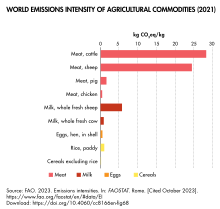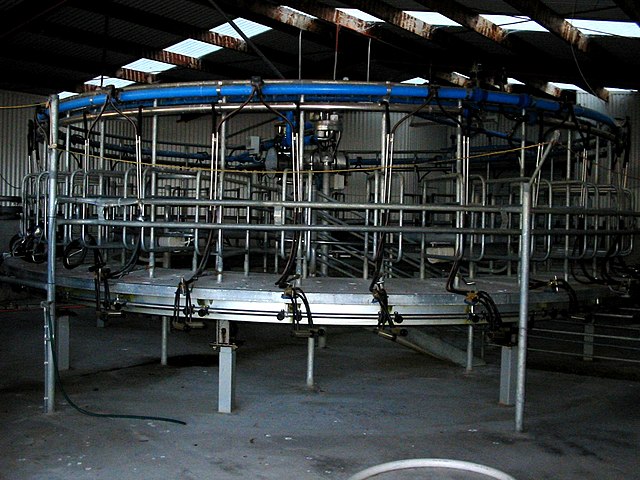Sheep's milk
Dairy product From Wikipedia, the free encyclopedia
Dairy product From Wikipedia, the free encyclopedia
Sheep's milk (or ewes' milk) is the milk of domestic sheep. It is commonly used to make cultured dairy products, such as cheese. Some of the most popular sheep cheeses include feta (Greece), Pecorino romano (Italy), Roquefort (France) and Manchego (Spain).
This article needs additional citations for verification. (October 2014) |

Specialized dairy breeds of sheep yield more milk than other breeds. Common dairy breeds include:
In the U.S., the most common dairy breeds are the East Friesian and the Lacaune.[1] Meat or wool breeds do not produce as much milk as dairy breeds, but may produce enough for small amounts of cheese and other products.

Female sheep (ewes) do not produce milk constantly. Instead, they produce milk during the 80–100 days after lambing.[2] Sheep naturally breed in the fall, which means that a majority of lambs are born in the winter or early spring. Milk production decreases and eventually stops when lambs are weaned or the days are shorter.[1] Milk cannot be produced year-round.[3] Through the use of controlled internal drug release (CIDR), ewes can be bred out of season. CIDR drugs contain progesterone, which is slowly released into the bloodstream, bringing the animal into estrus.[4] In this way, ewes can be bred at different times throughout the year, providing farms with a year-round supply of milk.
Meat and wool breeds of sheep lactate for 90–150 days, while dairy breeds can lactate for 120–240 days. Dairy sheep can produce higher yields of milk per ewe per year. Dairy sheep can produce 400–1,100 lb (180–500 kg) of milk per year while other sheep produce 100–200 lb (45–91 kg) of milk per year. Crossbred ewes produce 300–650 lb (140–290 kg) of milk per year.[1]
Sheep milk cheeses include the feta of Greece, Roquefort of France, Manchego of Spain; Serra da Estrela from Portugal; pecorino Romano (the Italian word for sheep is pecora) and pecorino Sardo of Italy; Pag cheese of Croatia; Ġbejna of Malta; and Gomolya of Hungary; and Bryndza (Slovenská bryndza from Slovakia, brânza de burduf from Romania and Bryndza Podhalańska from Poland).
Whey cheeses are also made from sheep's milk: various ricottas of Italy (but the best-known are made from buffalo milk); anthotyros, mizithra, manouri, and xynomizithra of Greece (often with goat milk mixed in); various requeijão in Portugal.
In Greece, yogurt is often made from sheep's milk.

| Constituents | Unit | Cow | Goat | Water buffalo | Sheep |
|---|---|---|---|---|---|
| Water | g | 87.8 | 88.9 | 81.1 | 83.0 |
| Protein | g | 3.2 | 3.1 | 4.5 | 5.4 |
| Fat | g | 3.9 | 3.5 | 8.0 | 7.0 |
| —Saturated | g | 2.4 | 2.3 | 4.2 | 3.8 |
| —Mono-unsaturated | g | 1.1 | 0.8 | 1.7 | 1.5 |
| —Polyunsaturated | g | 0.1 | 0.1 | 0.2 | 0.3 |
| Carbohydrate (lactose) | g | 4.8 | 4.4 | 4.9 | 5.1 |
| Energy | kcal | 66 | 60 | 110 | 95 |
| kJ | 275 | 253 | 463 | 396 | |
| Cholesterol | mg | 14 | 10 | 8 | 11 |
| Calcium | IU | 120 | 100 | 195 | 170 |
Sheep's milk is exceptionally high in fat and conjugated linoleic acid (CLA) and has a high level of solids,[6] as compared to other kinds of milk, making it very suitable for cheese-making. In particular, sheep's milk produces much more cheese than the same amount of cow's milk.[7]
Seamless Wikipedia browsing. On steroids.
Every time you click a link to Wikipedia, Wiktionary or Wikiquote in your browser's search results, it will show the modern Wikiwand interface.
Wikiwand extension is a five stars, simple, with minimum permission required to keep your browsing private, safe and transparent.